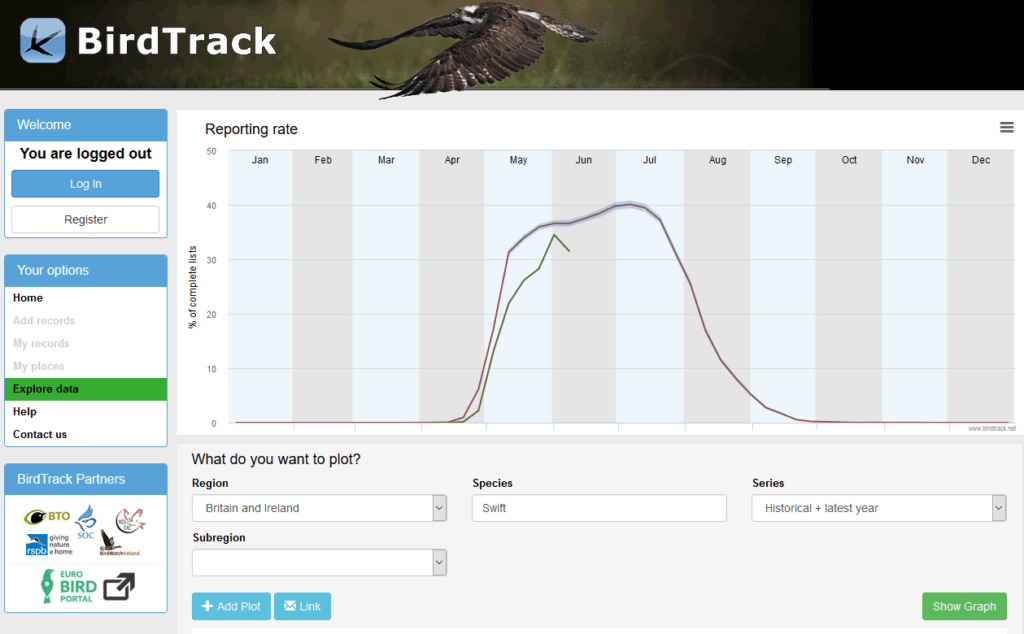
Conservationists concerned about late swift return
- This spring, nesting swifts here are arriving later than usual
- Swift experts have produced new advice for ecologists working on new housing developments to provide homes for these birds
- Let the RSPB know where you see swifts nesting or flying at rooftop level in the RSPB Swift Survey
- Celebrate swifts at your nearest Swift Awareness Week event (22-30 June)
Wildlife experts who work to save the UK’s dwindling swift population are concerned at the late arrival of these birds, which nest here after spending the winter in Africa. Many swifts have arrived up to two weeks late, and the RSPB has received numerous calls and emails from people concerned at their absence.
What might have caused this delay? Swifts would normally begin their journeys north from Africa in April. Their epic 6,000 mile journey is often fraught with hazards but weather conditions this year may have made migration especially difficult.
When the birds arrived in Europe, they were faced with serious climatic challenges. This year there have been distressing stories from Italy and Spain showing that swifts, some of which may have been on their way to UK nest sites, have even been killed by storms and cold wet weather. Doomed to die of starvation and hypothermia, they have been trying to survive overnight by clinging to each other on walls to avoid the wind and rain.
Swift expert Edward Mayer, who runs the Swift Conservation website and free advice service, says “There has been some really appalling spring weather this year in Italy, France, Spain and the Balkans. Temperatures should have been in the 30s but were in the low teens, and much lower at night, with prolonged rain storms making things even worse. This suppresses the swifts’ flying insect food, soaks and chills them – and can kill them”.
The
unseasonably low temperatures in southern Europe will have made life
even harder for these small birds desperately needing to refuel for the
final leg of their journey. Then predominantly northerly winds have made
flying north even harder.
Although
these are extraordinarily resilient birds, swifts that make it to the
UK face further challenges. They typically nest under the eaves of
houses but in recent years many of these spaces have been blocked up
leaving the birds with the difficult task of finding somewhere new to
raise their young during the limited time they spend here. The RSPB ran a
campaign between February and April to encourage people to make new
homes for them, by buying either a specially made nestbox or making one
of their own.
“Swifts have huge public support in the UK” says Jamie Wyver, the RSPB’s Swift Lead. “Our supporters and social media followers are incredibly enthusiastic about them, and earlier this year we sold well over 1,000 new swift nestboxes! As well as our own regional teams working hard to make sure these birds have plenty of places to nest, there are around 75 independent local swift groups.”
The RSPB’s John Day and fellow swift experts Dick Newell and Edward Mayer recently had published a co-authored article providing advice for ecologists in the membership journal of the Chartered Institute for Ecology and Environmental Management (CIEEM). The article outlines ways in which new building developments can easily accommodate homes for swifts, neatly built inside wall cavities. These “nest bricks” should be added typically in small clusters of two to four to gables of houses, as swifts prefer to nest close to one another.
Everyone can help swifts this summer by adding sightings of the birds nesting or flying around roofs to the RSPB’s Swift Survey: rspb.org.uk/swiftsurvey. Data gathered in the survey are used to show which sites are most important for swifts.
There’s also an opportunity to get out and enjoy the swifts that have made it back this year and learn how to help boost their numbers during Swift Awareness Week, from Saturday 22 to Sunday 30 June. This will highlight the plight of this iconic bird and show how everyone can help by, for example putting up swift nest boxes and gardening for wildlife. Over 70 local events have been organised during the week so far, from the south coast to the north of Scotland. Further details of each event can be found on the Action for Swifts website: https://actionforswifts.blogspot.com/p/2019-swift-awareness-week.html .
ENDS

Reported my Swifts. Mine were exactly 2 weeks later than usual and I only have two Swifts flying around… numbers were already down to five in recent years. So very sad. Will look into putting boxes up.
Pretty much everywhere I go there are new, massive housing estates being built on farm land.
How many of these estates will have swift, house sparrow or starling boxes??
I bet less than 1 or 2%.
Developers and the government have no interest at all.
Daniel – building nest boxes into new houses for variety of species seems pretty much a no-brainer to me.
I couldn’t agree more Mark. But this country is currently building homes at an astounding rate and very few developers have any interest in this.
Solar panels should also be a requirement of new homes.
Daniel – I agree with that too.
I have seen some swift towers and they stand alone so you don’t even need a building not sure of the success rate.
Swift Awareness Week (22-30 June) now has nearly 90 local events organised. Nearly all have been set up by local swift groups of which there are more than 70 across the UK.
Interestingly, 90% of them are run independently of any wildlife NGO, showing again how much wildlife conservation depends on volunteers just getting on and doing things.
If there’s no swift group in your neck of the woods then perhaps you could set one up? Lots of help is available via the very active Swift Local Network which communicates via a (closed) yahoo group. Details and links are on the excellent Action for Swifts blog.